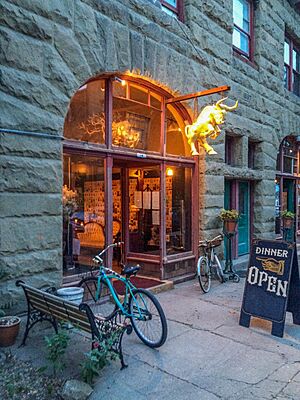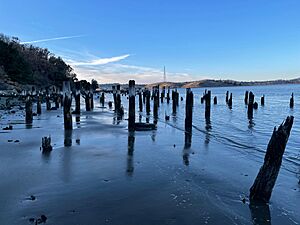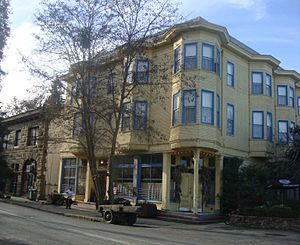Port Costa, California facts for kids
Quick facts for kids
Port Costa
|
|
|---|---|
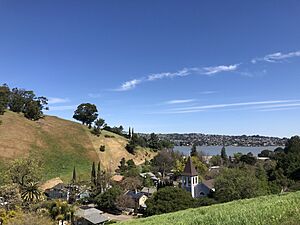
Port Costa
|
|
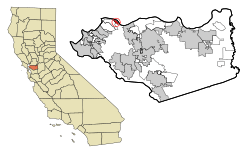
Location in Contra Costa County and the state of California
|
|
| Country | |
| State | |
| County | Contra Costa |
| Area | |
| • Total | 0.158 sq mi (0.41 km2) |
| • Land | 0.158 sq mi (0.41 km2) |
| • Water | 0 sq mi (0 km2) 0% |
| Elevation | 16 ft (5 m) |
| Population
(2010)
|
|
| • Total | 190 |
| • Density | 1,200/sq mi (464/km2) |
| Time zone | UTC-8 (PST) |
| • Summer (DST) | UTC-7 (PDT) |
| ZIP code |
94569
|
| Area code | 510, 341 |
| FIPS code | 06-58226 |
| GNIS feature IDs | 230948, 2409091 |
Port Costa is a small town in Contra Costa County, California. It is also known as a census-designated place (CDP), which means it's a special area defined by the government for counting people. Port Costa is located in the East Bay part of the San Francisco Bay Area. It sits on the southern shore of the Carquinez Strait. In 2020, about 190 people lived there.
Contents
History of Port Costa
Port Costa was started in 1879. It was a special place for a large railroad ferry called the Solano. This ferry was run by the Central Pacific Railroad. Because of this ferry, Port Costa became an important stop on the main route of the transcontinental railroad, which was a railway that crossed the entire country.
The Solano ferry, and later another ferry called the Contra Costa, would carry whole trains across the Carquinez Strait. They went from Benicia to Port Costa. From Port Costa, the trains would then continue their journey to the Oakland Pier.
Early Development and Wheat Shipping
A businessman named George W. McNear built the Port Costa Warehouses and Dock Company in 1880. This was just west of the new ferry terminal. The area where Port Costa is now, once called Bull Valley, was part of a large ranch. In 1883, McNear bought this land and started to build up the town.
Port Costa soon became the busiest port on the West Coast. Its main business was shipping wheat.
Important Buildings and Industries
Port Costa's first post office opened in 1881. It later moved into a large warehouse built by McNear, where it still is today. The Port Costa School was built in 1911 and opened in 1912. It was a beautiful building designed in a classical style. The school was used until 1966. In 1988, it was added to the National Register of Historic Places, which lists important historical places. St. Patrick Church was built in 1884, rebuilt in 1898, and fixed up in 1980.
For many years, most of the town's business happened on the wharves and docks along the waterfront. These docks caught fire many times between 1883 and 1941. A big part of the "Waterfront Port Costa" area was torn down in 1921. This happened after it was badly damaged by tiny sea creatures called shipworms. Today, no docks or wharves are left, but you can still see some of the old wooden poles (pilings) sticking out of the water.
Besides the railroad and shipping, another important business in Port Costa was making bricks. The Port Costa Brick Works made bricks from 1905 until 1991.
Decline and Revival
In the early 1900s, California started producing less wheat. Also, in 1930, the Southern Pacific Railroad (which took over from the Central Pacific) built a new railroad bridge in Martinez. This bridge replaced the ferry crossing. Because of these changes, Port Costa became less important and its population went down.
In 1963, a man named Bill Rich bought and fixed up several buildings in Port Costa. These included the Burlington Hotel (built around 1883) and McNear's warehouse (built 1886). His goal was to make the town a fun place for tourists to visit. For a while, the warehouse had many antique shops and even a museum. However, Port Costa faced problems again after a big fire in 1983.
In 1999, the Warehouse Cafe, which is in McNear's old warehouse, got a new owner. Over the years, this cafe became very popular. In 2012, the Bull Valley Roadhouse restaurant, located in McNear's old office building, was renovated. The Burlington Hotel was also renovated in 2013. Today, Port Costa continues to be a popular place for people to visit for a day or a weekend trip.
Geography of Port Costa
Port Costa covers a small area of about 0.16 square miles (0.41 square kilometers), and all of it is land. The town is surrounded by rolling hills where cattle graze. These hills are managed by the East Bay Regional Park District. The Carquinez Strait Regional Shoreline is a beautiful park area that stretches from Crockett through Port Costa and all the way to Martinez. A creek called Big Bull Valley Creek flows along McEwen Road. It goes into an old reservoir just above the town, and then flows underground beneath the town into the Carquinez Strait.
Population of Port Costa
In 2010, the United States Census reported that Port Costa had a population of 190 people. This means there were about 1,200 people per square mile. Most of the people living in Port Costa were White (90.5%). There were also smaller numbers of African American, Native American, and Asian residents. About 5.3% of the people were of Hispanic or Latino background.
There were 99 households in Port Costa. About 15 of these households had children under 18 living in them. Many households were made up of married couples. Some households had only one person living there, and about 9 of these had someone aged 65 or older living alone. The average household had about 1.92 people.
The population included:
- 19 people (10%) under 18 years old
- 13 people (6.8%) aged 18 to 24
- 38 people (20%) aged 25 to 44
- 80 people (42.1%) aged 45 to 64
- 40 people (21.1%) aged 65 or older
The average age of people in Port Costa was 52.5 years.
Notable People from Port Costa
- Clayton Bailey and Betty Graveen Bailey
See also
 In Spanish: Port Costa para niños
In Spanish: Port Costa para niños



